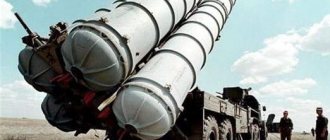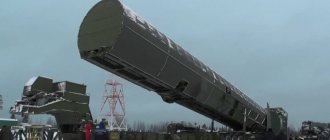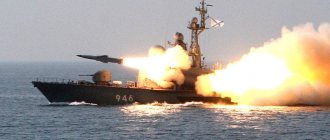The Ministry of Defense chose "Caliber"
We are talking about very expensive weapons, and the military uses them to solve particularly important problems. But even in peacetime they cannot do without training launches. Therefore, the Russian Ministry of Defense is increasing such orders. And he has been doing this for the past few years. According to the department, due to such contracts, since 2012, the number of carriers of high-precision weapons in the Russian army and navy has increased 13 times. And the number of ground, air and sea-based cruise missiles there has increased 37 times.
Let us explain what kind of weapon this is and why it is so important for generals to have it in their military arsenals. For example, the Caliber naval strike systems, the Kh-101 cruise missiles of the Russian Long-Range Aviation, and the Iskander land operational-tactical systems are classified as strategic non-nuclear forces. In practice, this means that, even without using nuclear weapons, such systems help generals and admirals solve strategic problems. Their use has a significant impact on the course of a major battle, and even makes it possible to turn the tide in the theater of military operations. Although we are talking about the latest strike systems, they have already proven their exceptional effectiveness in real combat situations. Suffice it to recall the devastating impact on terrorists in Syria that the massive strikes of Russian strategic missile carriers Tu-160, Tu-95MS and supersonic bombers Tu-22M3 had on control points, positions and warehouses of militants. Then the pilots also used X-101 missiles.
The surprise attack with high-precision Caliber cruise missiles, which our ships carried out in November 2015 against terrorists from the Caspian Sea, is generally worthy of study in military universities.
Or take the operational-tactical Iskanders. At one time, their appearance in the Russian army caused a lot of noise in the West. Now this unique equipment is available in all military districts of Russia, and several missile formations are based in some of them. With an interval of one minute, this complex can fire two ammunition, including a cruise missile, and control them throughout the flight.
In terms of power, the Iskander's weapons are equivalent to a nuclear bomb. Moreover, its missiles themselves can carry a nuclear warhead. The undoubted advantage of the complex is its mobility. Moving covertly from place to place, he remains elusive to the enemy. In addition, the mobility of the Iskander guarantees the surprise of a missile strike.
Both an ordinary missile and a cruise missile fly over a distance of about 500 kilometers and carry a combat load not exceeding half a ton. Despite the fact that the ammunition gains altitude from 20 to 50 kilometers, its deviation from the target does not exceed seven meters. The unpredictable trajectory and invisibility to radars, which is guaranteed by stealth technology, makes the Iskander virtually invulnerable to the American Patriots and their European counterparts. Therefore, experts say: unique military equipment is indispensable for the destruction of all anti-aircraft and anti-missile systems existing in the world, as well as military airfields, army control and communications centers.
Photo: RG Infographics / Alexander Chistov / Yuri Gavrilov
“Made with us” and on Yandex.Zen
if you know how the network structure of, say, a small plant or factory with 1000 computers with data backup systems and emergency power supply systems is built, then I’m thinking about the entire state, especially the most developed in the world in terms of network infrastructure and data backup, etc., etc. it’s simply pointless to talk . to cause serious damage to their network infrastructure, we don’t have enough missiles, not the Pendos themselves. Data centers to bring them down in the same way in the states, it’s not measured how and what is reserved there, I think it’s partly a secret, especially what is connected with social security with personal data for each black person, etc. The financial sector is already in any country at the moment the most well-protected and reserved network and information infrastructure and even partial loss of information will be restored from transactions with other counterparties and global financial structures.
Therefore, there can be no talk of any physical attacks on the network infrastructure, as well as on the life support structure such as energy, water supply, etc. - this entire system in the states, like ours, can be controlled in an autonomous manual mode for efficiency is controlled, of course, by computer systems and it is through them that an effective attack is possible - which can temporarily disable infrastructure objects. That is, it is possible to attack the network and information structure without it, that is, elements of cyber warfare - I doubt that in this we are very much on the same level as mattresses - I think it is possible to carry out local operations, but it seems to me that our cyber troops are not yet capable of carrying out a large-scale attack - there is very little experience and Not the best specialists we have there, all the big-headed IT specialists work there, mostly all in the private sector - I don’t know how in the mattress, but I think that there the level of salaries of IT specialists who work for the state and for all sorts of Microsoft is approximately the same and the smart people in their so-called cyber army are larger than ours.
And regarding where the mattress pads are going to fight, this is a misconception, and an absolute one, they are always ready for a missile attack on their territory, which is why missile attack warning stations are deployed there, it is there that Patriot complexes are deployed, it is there that AWACS and PLO aircraft and various aircraft are based at the bases and constantly patrol the borders radio aircraft, etc. reconnaissance. And to intercept anything that might fly in, the same F-22s are based there - for which the USA is the main base and the main object of protection.
But this is already the last line of defense for mattress covers. The main battlefield and protection for them is the world ocean where today they will destroy the fleet of any country in the world to smithereens - after all, even in order to strike a Kr you need to go to the strike distance for a submarine or nuclear submarine this is 2k km for YES this is about 4 thousand km. That is why our main means of overcoming the air defense of a mattress were supersonic bombers such as the 160 - which can simply quickly enter the launch area and leave it just as quickly. But the main task was still the destruction of the AUG - this is the main echelon of defense of the Pendos, after the destruction of most of the AUG, we can talk about the possibility of effectively attacking their territory - that is, military bases and other infrastructure. And similar means of attacking the AUG were our main sword and shield under the USSR this is the apl antey tu 22m3 tu 160 apl pike - their task was to destroy this main echelon of defense of the mattress, and then the path to their territory is considered open. Now, of course, the possibilities of confronting the AUG, as for me, have significantly decreased - the Granit missiles at Antey are unlikely to pass the AUG missile defense - therefore they need to be transferred to new supersonic calibers or the T22M3 onyxes have been cut out quite a lot and their main weapons are supersonic anti-ship missiles, which are also already outdated, well, the Tu 95 weapons and the 160 has the same problems as the 22m3 - they are more likely to go to the second echelon as carriers of the missile launcher for a strike on enemy territory.
Once the real effectiveness of confrontation with AUGs is restored, then we will be able to talk about parity of forces in the world’s oceans - but for now I think we will not be able to penetrate this armor.
And also about the disconnection of communications energy, etc. - I would be more worried about our country in view of even smaller financial and material resources and a much larger territory, that is, the difficulty of fast logistics of energy resources and equipment. Well, I can also add that the energy system, both ours and that of the mattress, is one of the best in the world in terms of stability and autonomy - that is, they do not depend on external networks, and even if several links are removed from the network, the rest of the network will function perfectly like ours so do they. Attacks on the energy system will only be effective against small states that are not included in other energy systems or have a local closed energy generation network, and there will be a complete blackout - remember Crimea two years ago, then you will understand what I mean.
Attacks on a developed network system are practically useless, be it an information network or an energy network - such systems can only be temporarily disabled, and then only by attacking the network from the inside.
“The Hidden Threat”: Why American airliners loaded with cruise missiles are dangerous for Russia
The difficult economic situation in which the Boeing Corporation finds itself is forcing it to look for new ways to subsidize from the military budget.
The American press has recently been actively talking about the possibility of reviving the long-forgotten Pentagon project to create a so-called “cruise missile carrier” based on civilian airliners. Will Boeing be able to lobby for its initiative, and if so, what danger can such “civilian missile carriers” pose to our country? The emergence of effective air defense systems in the USSR during the Cold War showed that height was no longer reliable protection for American bombers, since the use of free-fall ammunition was radically difficult. At the same time, the Vietnam War demonstrated that the potential for using the B-52H “stratospheric fortresses” against Third World countries is still very large. Therefore, the Pentagon eventually came to the concept of massive launch of cruise missiles from a safe distance outside the range of the air defense system. For this, a conventional subsonic aircraft capable of carrying a large load and delivering missiles to the launch point was quite sufficient.
CMCA (Cruise Missile Carrier Aircraft)
The idea of using civilian airliners for military needs arose even earlier.
On the basis of conventional transport aircraft, aerial tankers and AWACS aircraft were created. Equipping them with launchers for cruise missiles seemed like a rather promising undertaking, since it provided a lot of advantages. The same Boeing airliners have a long flight radius, low fuel consumption, are mass produced, and it is possible to disguise an armed aircraft as a standard civilian one and deliver an unexpected strike. This is how the Boeing 747 CMCA version was created with nine drums located in the tail section. In total, they stored 72 AGM-86 ALCM air-launched cruise missiles, which could be fired from the opened hatch in less than 15 minutes. Such a rate of fire made it pointless to direct the fighter to intercept it. In addition, the great advantage of a civilian airliner over military aircraft was its impressive size, which made it possible to place a lot of control equipment inside, turning it into an air command post. The Boeing 747 CMCA was technically unified with the E-4 Nightwatch. It was assumed that hundreds of such “werewolves” would be enough to replace the “stratospheric fortresses”. The Pentagon especially liked the idea of the possibility of launching a preventive strike from such “cruise missile carriers” on the territory of the Soviet Union from air routes passing along its borders. Also, civilian airliners converted into missile carriers could be used for air strikes on the infrastructure of Third World countries.
All leading American aircraft corporations then joined the competition for the Pentagon budget. McDonnell-Douglas proposed arming its DC-10 airliner with 42 cruise missiles. Lockheed presented two options at once: the L-1011 CMCA with 50 missiles and the C-5 Galaxy with 110 missiles. Boeing also proposed arming its YC-14 with 36 missiles as a fire support aircraft for troops in non-nuclear conflicts. The project received approval and support from the Pentagon.
The idea is actually quite good, it’s a pity that it is directed against our country. Therefore, we should be glad that it was never implemented at the time. The reason is simple: even the United States did not have enough money for everything at once. The Pentagon chose to go by re-equipping the reliable and proven B-52 “stratospheric fortresses” with ALCM missiles, funding the development of a stealth bomber and creating a supersonic low-altitude B-1B to break through air defense systems.
Nowadays
Today, the likelihood of returning to this old project is very high.
Firstly
, Boeing, a “national treasure” of the United States, is in dire need of financial support. Despite the fact that it is in “effective private hands,” the corporation found itself in a severe crisis and without government subsidies in the form of a program for converting civilian airliners into military aircraft, it may not survive it.
Secondly
, in the USA a new type of free-falling ammunition called CLEAVER (Cargo Launch Expendable Air Vehicles with Extended Range) has been developed and successfully tested. It is designed to be dropped from conventional military transport aircraft, which effectively turn into bombers. It’s clear that you can’t use them against a technically advanced enemy, like Russia or China, but against some Afghanistan or Libya - easily. A hundred CMCAs can bring down enormous striking power on the heads of the Barmaleys at once, even without the need to engage and expend the resources of real bomber aircraft.
Third
, the possibility of disguising an aircraft loaded with cruise missiles as an ordinary civilian airliner still poses a potential threat. Such “werewolves” can secretly concentrate at the airports of countries allied to the Americans, for example, in Ukraine or the Baltic states, and, taking off from there, deliver a preemptive strike on the infrastructure of the Russian Ministry of Defense.
The need to constantly track and identify such “shifters” will become a constant headache for Russian or Chinese intelligence.
The main caliber of the Russian fleet
The cornerstone of the large-scale “calibration” of the fleet was the 3S14 universal ship-based firing system. This shipborne vertical launcher was developed by JSC Design Bureau of Special Mechanical Engineering, part of the Almaz-Antey concern. It is the Russian analogue of mk41 container installations for Tomahawks, Standard missiles of the missile defense system and anti-submarine missiles.
Launch of the Tamogawk missile
© EPA/US Navy
The Russian complex can also launch various types of missiles. It is unified for launching Caliber, Onyx and BrahMos missiles. In the future, the complex will also fire the promising hypersonic anti-ship missile Zircon.
The new generation of Russian surface ships of various displacements is equipped with a universal ship-based firing system. These are frigates of projects 22350 and 11356, corvettes of projects 20385 and 20386, missile ships of project 11661, small missile ships of projects 21631 and 22800. Optionally, the launcher option can be mounted on patrol ships of project 22160.
In addition to the new ones, ships of previous projects undergoing modernization will also gain the ability to use “Calibers”. Thus, according to former Navy Commander-in-Chief Viktor Chirkov, in the near future, most Soviet-built ships of the Russian Navy will be armed with missile systems with Caliber and Onyx missiles. Among them are Project 1144 cruisers, Project 956 destroyers and Project 1155 large anti-submarine ships.
We should not forget about underwater carriers of cruise missiles. "Caliber" can be used by nuclear submarines of Project 885 "Yasen" and - as secondary weapons - submarines of Project 955 "Borey", as well as diesel-electric submarines of Project 636.3 "Varshavyanka" and Project 677. About how many missiles each will receive Of the ships being modernized, it is difficult to say, since plans for their modernization are periodically adjusted. However, it is possible to count the carrier ships already in the fleet, as well as estimate the potential increase when commissioning those already under construction.
So, with a rough calculation, adding up the carriers in service and those preparing for commissioning in 2018–2019, the Russian Navy can theoretically already launch more than 200 cruise missiles in one salvo. With the commissioning of all contracted new ships and boats after 2023, this number will increase to more than 500. Even without missiles on the ships being modernized, the number of which is now difficult to estimate, the figure is already impressive.











